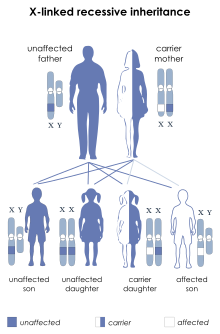
Back فقد غاماغلوبولين الدم المرتبط بالصبغي إكس Arabic Bruton xəstəliyi Azerbaijani X-vezana agamaglobulinemija BS Agammaglobulinèmia lligada al cromosoma X Catalan Brutonova agamaglubulinémie Czech Bruton-Syndrom German Agammaglobulinemia ligada al cromosoma X Spanish X-rekin lotutako agammaglobulinemia Basque Agammaglobulinémie liée au sexe French XLA HE
| X-linked agammaglobulinemia | |
|---|---|
| Other names | X-linked hypogammaglobulinemia, Bruton type agammaglobulinemia, Bruton syndrome, sex-linked agammaglobulinemia[1]: 83 |
 | |
| The disorder is passed on in an X-linked recessive pattern | |
| Specialty | Immunology |
X-linked agammaglobulinemia (XLA) is a rare genetic disorder discovered in 1952 that affects the body's ability to fight infection. As the form of agammaglobulinemia that is X-linked, it is much more common in males. In people with XLA, the white blood cell formation process does not generate mature B cells,[2] which manifests as a complete or near-complete lack of proteins called gamma globulins, including antibodies, in their bloodstream. B cells are part of the immune system and normally manufacture antibodies (also called immunoglobulins), which defend the body from infections by sustaining a humoral immunity response. Patients with untreated XLA are prone to develop serious and even fatal infections. A mutation occurs at the Bruton's tyrosine kinase (Btk) gene that leads to a severe block in B cell development (at the pre-B cell to immature B cell stage) and a reduced immunoglobulin production in the serum. Btk is particularly responsible for mediating B cell development and maturation through a signaling effect on the B cell receptor BCR. Patients typically present in early childhood with recurrent infections, in particular with extracellular, encapsulated bacteria.[3] XLA is deemed to have a relatively low incidence of disease, with an occurrence rate of approximately 1 in 200,000 live births[4] and a frequency of about 1 in 100,000[5] male newborns. It has no ethnic predisposition. XLA is treated by infusion of human antibody. Treatment with pooled gamma globulin cannot restore a functional population of B cells, but it is sufficient to reduce the severity and number of infections due to the passive immunity granted by the exogenous antibodies.[3]
XLA is caused by a mutation on the X chromosome (Xq21.3-q22) of a single gene identified in 1993 which produces an enzyme known as Bruton's tyrosine kinase, or Btk.[3] XLA was first characterized by Dr. Ogden Bruton in a ground-breaking research paper published in 1952 describing a boy unable to develop immunities to common childhood diseases and infections.[6] It is the first known immune deficiency, and is classified with other inherited (genetic) defects of the immune system, known as primary immunodeficiency disorders.
- ^ James, William D.; Berger, Timothy G.; et al. (2006). Andrews' Diseases of the Skin: clinical Dermatology. Saunders Elsevier. ISBN 0-7216-2921-0.
- ^ "X-linked Agammaglobulinemia: Immunodeficiency Disorders: Merck Manual Professional". Retrieved 2008-03-01.
- ^ a b c X-Linked Agammaglobulinemia Patient and Family Handbook for The Primary Immune Diseases. Third Edition. 2001. Published by the Immune Deficiency Foundation
- ^ Chun, Jin-Kyong; Lee, Taek Jin; Song, Jae Woo; Linton, John A; Kim, Dong Soo (2008-02-29). "Analysis of Clinical Presentations of Bruton Disease: A Review of 20 Years of Accumulated Data from Pediatric Patients at Severance Hospital". Yonsei Medical Journal. 49 (1): 28–36. doi:10.3349/ymj.2008.49.1.28. ISSN 0513-5796. PMC 2615253. PMID 18306466.
- ^ Mahmoudi, Massoud (2007). Allergy and Asthma: Practical Diagnosis and Management. McGraw-Hill Professional. ISBN 978-0-07-147173-2.
- ^ Bruton OC (1952). "Agammaglobulinemia". Pediatrics. 9 (6): 722–8. doi:10.1542/peds.9.6.722. PMID 14929630. S2CID 245180200.. Reproduced in Buckley CR (1998). "Agammaglobulinemia, by Col. Ogden C. Bruton, MC, USA, Pediatrics, 1952;9:722-728". Pediatrics. 102 (1 Pt 2): 213–5. doi:10.1542/peds.102.S1.213. PMID 9651432.
© MMXXIII Rich X Search. We shall prevail. All rights reserved. Rich X Search